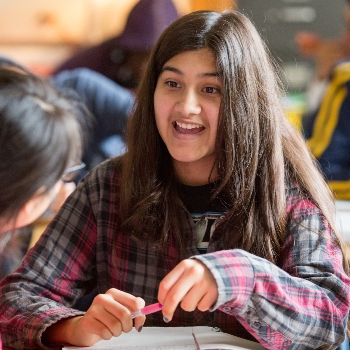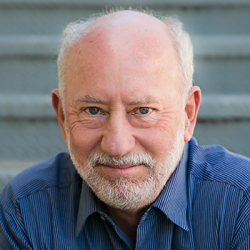 Like a lot of things about PBL, student voice and choice sounds simple on the surface but has deeper layers if you drill down. I was led to consider some new aspects of this Essential Project Design Element in a recent hangout discussion with some of our deep-thinking National Faculty members, Jennifer Klein, Kristyn Kamps, and Mike Kaechele.
Like a lot of things about PBL, student voice and choice sounds simple on the surface but has deeper layers if you drill down. I was led to consider some new aspects of this Essential Project Design Element in a recent hangout discussion with some of our deep-thinking National Faculty members, Jennifer Klein, Kristyn Kamps, and Mike Kaechele.
Why provide opportunities for students to have voice and choice in PBL? It’s often noted that being able to make choices is motivating for students. It makes them less passive, more active. But for some kids, we agreed, voice and choice in a project is really a “make or break” element. Without it, a project can feel like just another assignment given by the teacher – except longer and harder.
“We have to stop doing school to kids,” Mike said. “Make it more about what they care about.”
Kristyn added that many 7th and 8th grade students know that what they do before high school “doesn’t count.” But at that age they also feel like they’re “ready to contribute, so if they’re not allowed that chance, they can shut down very quickly.”
Another layer was added by Jennifer, who said, “It’s a 21st century imperative.” She explained that, to meet the challenges facing the world today and in the future, we‘re going to need leaders and problem-solvers who will take initiative. Schools can help create these citizens by letting kids explore what matters to them – when given voice and choice in PBL – and teaching them how to tackle real-world problems.
Here are some of the best practices and tips shared by our National Faculty members:
- Consider the purpose of giving students voice and choice; why are you offering it? Would it be done in a comparable real-world project? Don’t offer it just because they ask or it’s what you think you’re “supposed to do” in PBL.
- Voice and choice should be limited at times, just like in the real world, where we often work under constraints. For example, adults can’t always choose their own work groups. Or think of an architect who is constrained by budgets, building codes, location, and client preferences.
- Too much choice can be paralyzing for students, so provide scaffolding. Especially for students who are new to PBL, some structure is needed, and you can always given them more freedom. For example, instead of allowing totally wide-open choice of products in a project, have them pick from a list.
- Create a list of product options with students, so they won’t feel like they’re being over-directed by the teacher. And as Jennifer noted, the divergent thinkers in your class will come up with 15 options you had not thought of! (Mike said he sometimes tells students what they can’t do – e.g., “no slide presentations” if they’ve become too common.)
- Find out what your students are interested in; conduct a survey or inventory at the beginning of the year.
- If you’re new to PBL, create opportunities for voice and choice before you launch projects, too. This allows students to understand what it means to have voice and choice and learn how to exercise it – and helps build a culture conducive to PBL. These “practice runs” also allow teachers to experience what it’s like (if they haven’t done so in the past) to give up some control over the classroom.
The content coverage issue
We acknowledged another challenge when it comes to voice and choice, especially at the secondary level where, as Jennifer put it, “content trumps everything.” Teachers might worry that if student teams choose a certain aspect of a topic, they will miss other aspects, and potentially be “missing” a key piece of knowledge. This gets more into the pedagogical weeds than we had time for, but it is to some extent an issue of what do students really need to learn; how much content do teachers really have to “cover”? (The answer usually is, “less than we used to think.”) We mentioned that this challenge can be addressed by proper project design and scaffolding – e.g., the requirements for products, peer feedback systems, jigsawed group work, and guidance for students to help them make good choices.
Voice is distinct from choice
One other point came up that I think bears repeating: providing opportunities for hearing student voice goes beyond just giving them choices. Mike gave the example of the MyParty Election project, in which students create their own political parties and it is key that they make their own opinions heard. I also thought of the Resilience Café project (link no longer available) from PBLU.org, where students write and perform spoken word poetry about their own identities, lives, and communities.
Another opportunity to hear student voice is at the end of a project, by asking them to reflect on the project itself – how it was designed, taught, carried out, what was learned, and so on. This might not always be consistently good news for the teacher, but Mike pointed out an important reminder:
if you give students a voice, you have to be willing to listen. (If not, he says, “they’ll call BS on you!”)
In conclusion, our guests gave some words of encouragement. Jennifer reiterated that we don’t need more repetition of what’s been done in the past; we need “classrooms that foster independent thinking.” Kristyn said that with voice and choice, “a child who’s totally disconnected in class may suddenly wake up and surprise you.” Mike offered, “When it comes to voice and choice, go for it – you won’t lose control of everything. Take the leap and the reward will pay off. You’ll see students do things they’ll never do in the classroom you’re controlling.”
I think each of those comments is Twitter-worthy – see you there!

